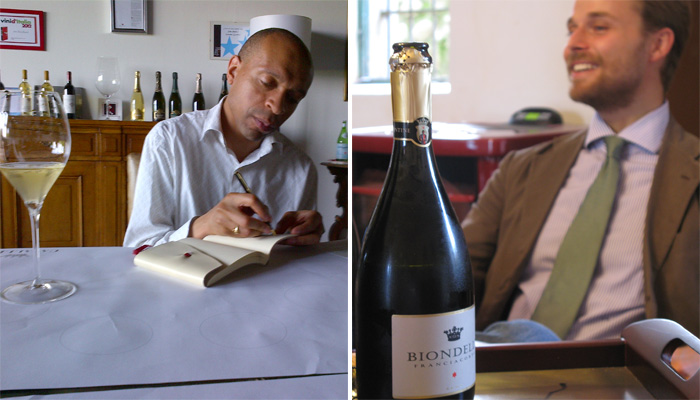Franciacorta, Italy’s ‘Champagne’ region, is bubbling to the surface…
Author: David Berry Green

Last week I visited Lombardia’s Franciacorta region accompanied by Edwin Dublin, one of Berry Bros.’ sparkling wine experts, who also works in our No.3 St James’s Street shop. For both of us this was our inaugural visit to the region. Over two days we visited seven cantine: Lantieri di Paratico, Bellavista, Biondelli, Monte Rossa, Cavalleri, Uberti and Berlucchi – so a mix of bigger brands, artisan and a few in between. What we concluded was that Franciacorta offers a very different wine to that of Prosecco: its superior quality echoing that of Champagne, albeit on a smaller scale: Franciacorta’s 15 million bottles/anno versus Champagne’s 340 million! What was made patently clear is that Franciacorta, like Champagne, is the name of the region, the style of wine and the method of making it; something that as far I know does not apply to any other sparkling wine region, bar Champagne.
Located northeast of Milano, close to Brescia, the 2,800 ha region was carved out of the sedimentary rock between 50 – 150,000 years ago by the toing and froing of an Alpine glacier. The glacier’s ‘tongue’ left a fan-like mark on the land, along with moraine debris deposits and a lake. Its path down from the Alps 50 km away also created a corridor down which cooling air shuttles, skimming over Lake Iseo’s surface and ventilating the vineyards beyond. A southern rim of hills, in particular Monte Orfano, in turn blocks the warm air currents travelling up from Italy’s south.
Franciacorta the wine was created in 1985, although it ‘won’ its DOCG status only in 1996; at which point it was forced to handover (to the French) the words ‘Metodo Champagne’ in return for registering the marks ‘Franciacorta’ and ‘Satèn’ (a smoother/satin style of Franciacorta made by using less sugar in the liqueur de tirage (20g rather than 24-26g) for the second fermentation so producing less pressure (around 4 bar rather than 6bar) & thus a finer bead (of bubbles), using only Chardonnay and Pinot Bianco). Prior to the 1980s boom, Franciacorta made still wine (back to the 16th century) and then tested the spumante market during the 1970s with fruit bought from Trentino and Oltrepo Pavese. The grapes now used are predominantly Chardonnay and Pinot Noir, with Pinot Bianco the ne’er-do-well relation making up the numbers (á la Pinot Meunier). In fact the story goes that with the surge of interest that followed the release of Berlucchi’s ‘Pinot di Franciacorta’ (that’s Pinot Bianco) during the 1970s, nurseries soon ran out of Pinot Bianco cuttings…so they sold the thirsty cantine ‘Chardonnay’ instead!
The way of making Franciacorta is very similar to that of Champagne: traditional method with the second, carbonic fermentation happening in bottle. Yields are at 100 hl versus 150 hl for Champagne. Time ‘sur lattes’ has to be a minimum 18 months (vs. 15 in Reims). The maximum amount of must allowed from the press is 85%. The maximum residual sugar/litre is 12 grams but now there’s a trend is towards drier styles. Some but not all estates have the luxury of using ‘reserve wines’, and even then the wines are not that old (1-2 years), so wines tend to be fresher than their Champagne counterparts. A key point of difference is that Franciacorta producers are obliged to put the date of ‘sboccatura’/disgorgement on the back label to inform consumers.
 Prices are in line with worthy Champagne; bullish you might say given the wine style is as good as unknown in the UK. But the market’s changing: ten years ago 95% of Franciacorta was drunk in Italy; now producers are keen to reduce this dependency on the home market.
Prices are in line with worthy Champagne; bullish you might say given the wine style is as good as unknown in the UK. But the market’s changing: ten years ago 95% of Franciacorta was drunk in Italy; now producers are keen to reduce this dependency on the home market.
So it seems, allowing for my ridiculously small sample group, there appears to exist in Franciacorta, as in Champagne, three categories of producer: ambitious brands making finely-tuned ‘bubbles’ (e.g. Bellavista, Monte Rossa, Berlucchi); ‘wannabe’ brands keen to fly from the nest (.e.g. Lantieri di Paratico); and those that are more interested in making high quality artisan wines than in the sparkle itself (e.g. Uberti, Cavalleri, Biondelli).
Which would you go for?




Fantastic to see another fan for Franciacorta. I am passionate about it and have been waging a small campaign to get more people in on the secret in the UK. I import Lantieri here if anyone wants to try a bottle and will happily talk for hours on the fine sparkling wines of northern Italy.
It’s really interesting and impressive to read about Franciacorta on bbr website. It might mean that the interest is growing.
My personal suggestions are Gatti, Arici, Ferghettina, Ca del Bosco. They have absolutely outstanding nature or dosage zero or extra brut Franciacorta.
Apart Ca del Bosco who shares with Bellavista the markets leadership the other have really appealing prices.
Thanks all – over the next two weeks I will be comparing three of the estates visited with Berrys’ suppliers from the sparkling wine regions of Champagne, Cava & from the UK (!) to see whether they offer enough quality & value to warrant listing. So watch this space!
[…] For years the market for these Champagne-like wines was Italy, notably the local Milanese. But a recent visit along with my colleague Edwin Dublin, one of Berrys’ experts on anything that fizzes, threw up […]
I found your article very interesting. It would be great to see more article as the region has had its fair share of change for the betterment. If you do happen to pass by, feel free to drop by at our luxury B&B in the heart of Franciacorta.
Cheers!